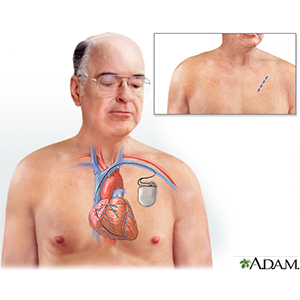WHAT YOU NEED TO KNOW: What do I need to know about implantable cardioverter defibrillator insertion? An implantable cardioverter defibrillator (ICD) is a small device that monitors your heart rate and rhythm. It is placed inside your chest or abdomen. It may be used if you have a life threatening arrhythmia. An arrhythmia is an irregular heart rate or a heart rate that is too fast or too slow. Some arrhythmias may cause your heart to suddenly stop beating. An ICD can give a shock to your heart to make it start beating again. It can also make your heart beat faster or slower. 
|
How do I prepare for insertion of an ICD? Your healthcare provider will talk to you about how to prepare for surgery. He may tell you not to eat or drink anything after midnight on the day of your surgery. He will tell you what medicines to take or not take on the day of your surgery. You may be given an antibiotic through your IV to help prevent a bacterial infection. You will need someone to drive you home and stay with you after the procedure. You will not be able to lift anything heavy. Ask your healthcare provider when you can return to work after your procedure. What will happen during insertion of an ICD? - You may be given general anesthesia to keep you asleep and free from pain during surgery. You may also be given a sedative and local anesthesia to numb the surgery area. With local anesthesia, you may still feel pressure or pushing during surgery, but you should not feel any pain. Your healthcare provider will make an incision in your chest or abdomen. A lead will be placed into a vein near your collarbone or neck and guided into your heart. You may have multiple leads placed into your heart.
- The other end of the leads are attached to the generator and placed in a pocket under your skin. This pocket is usually in the shoulder area, but may also be in the abdominal area. The generator has a metal shell with a battery and a small computer. The computer will monitor your heart rate and rhythm. If the computer senses an irregular heart beat it will send electricity from the generator through the leads to your heart. These electrical shocks will make your heart beat normally. Your healthcare provider will close the incision with stitches or staples. He may also place a bandage or tape over your incision.
What will the shocks from an ICD feel like? You may not notice the low energy shocks from your ICD or they may feel like a flutter in your chest. The high energy shocks are very short. They may feel like thumping or a painful kick in the chest. Your healthcare provider may give you medicine to decrease the number of high energy shocks. What will happen after ICD insertion? You will be taken to a recovery room where you will rest until you are awake. You will be on a heart monitor. A heart monitor is an EKG that stays on continuously to record your heart's electrical activity. You may need a chest x-ray to make sure the ICD is in the right place. You may be able to leave when you are awake and your pain is controlled or, you may go to a hospital room to spend the night. What are the risks of ICD insertion? You may bleed more than usual or get a blood clot after surgery. You may get an infection. The leads could poke a hole in your heart, lung, or vein. The leads may also cause arrhythmias when they are placed. Blood may collect in the pocket where the generator is placed and cause pain or an infection. The leads may disconnect or break, and you may need another surgery. You may also need another surgery to replace the entire ICD. Your ICD may not shock your heart when it needs it. It may also shock more than it should. |